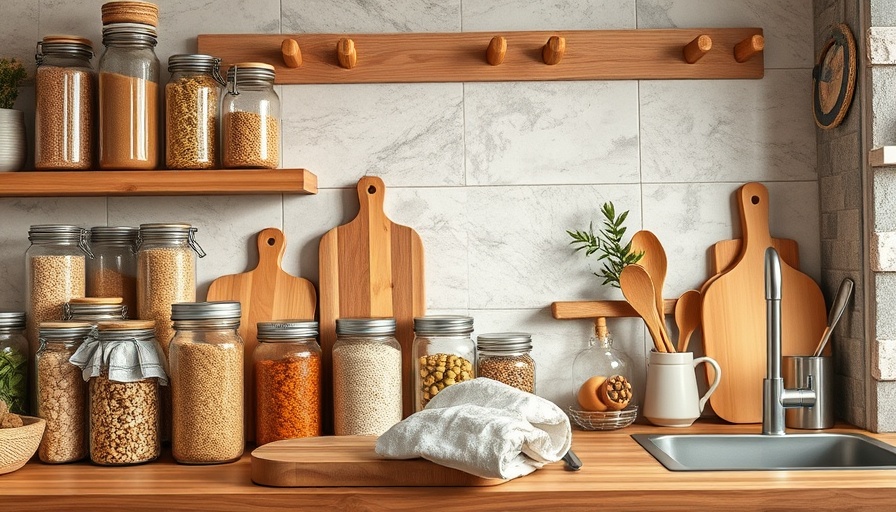
Understanding the Importance of a Zero-Waste Kitchen
In a world increasingly aware of its environmental footprints, adopting a zero-waste kitchen model is not just beneficial—it's essential. This eco-friendly approach revolves around minimizing waste by emphasizing reusability and recycling while actively working to eliminate single-use plastics and excessive packaging. With alarming statistics revealing that in 2019 alone, approximately 66 million tons of food waste was generated just in the U.S., the urgency of implementing sustainable practices in our kitchens becomes undeniable.
Such statistics indicate that one-third of food produced globally—around 1.3 billion tonnes—goes to waste every year, significantly contributing to greenhouse gas emissions. In 2023, over 2.33 billion people faced food insecurity, underscoring the need to reassess how we shop, cook, and dispose of kitchen remnants. By adopting a zero-waste philosophy, we have the power to conserve resources, reduce emissions, and potentially address issues like global hunger.
Steps to Establishing Your Zero-Waste Kitchen
Transforming your kitchen into a sustainable space begins with a few mindful steps:
Assess Your Waste Generation
Begin by logging your kitchen waste over the course of a week. Take note of food scraps, packaging items, and single-use products. This waste audit not only highlights shocking areas of wastefulness, but it also sets the groundwork for measurable goals. Whether you decide to cut food waste by 20% or fully eliminate single-use plastics, having a clear sense of your kitchen habits will guide your zero-waste journey.
Meal Planning: The Backbone of Sustainability
Effective meal planning is vital in combating waste. By plotting your meals for the week, you can avoid impulse buying and the resultant food spoilage that commonly occurs with over-purchasing. Research from the National Zero Waste Council illustrates that about 63% of wasted food in Canadian households could have been consumed, leading to an annual loss of approximately $1,300 per household. To kick off this process, assess your pantry and existing food supply, creating a shopping list for necessary ingredients. Opting for local markets or stores that permit bulk purchases not only helps in cutting down packaging waste but also supports local economies.
Embrace Bulk Shopping for Waste Reduction
Buying food items like grains, nuts, and spices in bulk allows you to minimize packaging waste effectively. Many zero-waste grocery stores present the option to bring in reusable containers, diminishing reliance on plastic bags. It's essential to understand that proper storage can also prolong food freshness—switching to airtight, reusable containers can prevent spoilage and enhance your kitchen's efficiency.
Transitioning to Reusable Alternatives
One significant step in adopting a zero-waste lifestyle is to swap traditional single-use products for reusable ones. This includes replacing paper towels with cloth rags crafted from old T-shirts, or investing in durable dishcloths made from sustainable materials. Such changes not only cut down on waste but can also contribute to a more cost-effective lifestyle over time.
Practical Tips for Every Household
Here are several actionable insights that can ease the transition to a zero-waste kitchen:
- Compost Food Scraps: Start composting your vegetable scraps, coffee grounds, and eggshells. A compost pile or bin enriches your garden and reduces landfill waste.
- Preserve Food Wisely: Engage in food preservation methods like canning or freezing surplus items to avoid waste, especially garden produce.
- Ditch Disposable Utensils: Invest in quality utensils, glass containers, and cloth bags to reduce disposable options.
Community Involvement: Join the Movement
Building a zero-waste kitchen shouldn't be an isolated endeavor. Engage with your community—whether it’s organizing or joining local workshops focused on sustainability or participating in neighborhood garden swaps. The spirit of collaboration fosters creativity and could lead to new ideas on how to minimize waste effectively.
Concluding Thoughts on Sustainable Living
The journey towards a zero-waste kitchen may seem daunting initially, but with a series of small, deliberate changes, you'll foster an environmentally sustainable living environment. By consciously assessing your waste, embracing smart shopping practices, and engaging with your local community, each action adds up toward creating a greater impact.
As homeowners in Folsom and El Dorado Hills, contributing positively to environmental conditions can inspire others to follow suit. The small adjustments made in your kitchen can ripple outwards, launching broader conversations about sustainability and responsible living.
Take the first step today by re-evaluating your kitchen habits, and remember, even the smallest actions can generate significant impact. Let’s engage in transforming our kitchens into zero-waste sanctuaries, paving the way for a greener future.
 Add Row
Add Row  Add
Add 




Write A Comment